Temporal Characteristics of Ozone (O3) in the Representative City of the Yangtze River Delta: Explanatory Factors and Sensitivity Analysis
Abstract
:1. Introduction
2. Materials and Methods
2.1. Observation Site
2.2. Measurement Apparatus and Methods
2.3. Generalized Additive Model
2.4. Observation-Based Model
3. Results and Discussion
3.1. Temporal Variations of Ambient O3 and Related Parameters
3.1.1. Seasonal Variation
3.1.2. Diurnal Variation
3.2. The Influencing Factors of O3 Using the GAM
3.3. Sensitivity of O3 Formation
4. Conclusions
Author Contributions
Funding
Data Availability Statement
Conflicts of Interest
References
- Xue, L.K.; Wang, T.; Gao, J.; Ding, A.J.; Zhou, X.H.; Blake, D.R.; Wang, X.F.; Saunders, S.M.; Fan, S.J.; Zuo, H.C.; et al. Ground-level ozone in four Chinese cities: Precursors, regional transport and heterogeneous processes. Atmos. Chem. Phys. 2014, 14, 13175–13188. [Google Scholar] [CrossRef] [Green Version]
- Wang, T.; Xue, L.; Brimblecombe, P.; Lam, Y.F.; Li, L.; Zhang, L. Ozone pollution in China: A review of concentrations, meteorological influences, chemical precursors, and effects. Sci. Total Environ. 2017, 575, 1582–1596. [Google Scholar] [CrossRef] [PubMed]
- Agathokleous, E.; Feng, Z.; Oksanen, E.; Sicard, P.; Wang, Q.; Saitanis, C.J.; Araminiene, V.; Blande, J.D.; Hayes, F.; Calatayud, V.; et al. Ozone affects plant, insect, and soil microbial communities: A threat to terrestrial ecosystems and biodiversity. Sci. Adv. 2020, 6, eabc1176. [Google Scholar] [CrossRef] [PubMed]
- Sicard, P. Ground-level ozone over time: An observation-based global overview. Curr. Opin. Environ. Sci. Health 2021, 19, 100226. [Google Scholar] [CrossRef]
- Wang, M.; Chen, W.; Zhang, L.; Qin, W.; Zhang, Y.; Zhang, X.; Xie, X. Ozone pollution characteristics and sensitivity analysis using an observation-based model in Nanjing, Yangtze River Delta Region of China. J. Environ. Sci. 2020, 93, 13–22. [Google Scholar] [CrossRef]
- Liu, H.; Liu, J.; Liu, Y.; Yi, K.; Yang, H.; Xiang, S.; Ma, J.; Tao, S. Spatiotemporal variability and driving factors of ground-level summertime ozone pollution over eastern China. Atmos. Environ. 2021, 265, 118686. [Google Scholar] [CrossRef]
- Coates, J.; Mar, K.A.; Ojha, N.; Butler, T.M. The influence of temperature on ozone production under varying NOx conditions – a modelling study. Atmos. Chem. Phys. 2016, 16, 11601–11615. [Google Scholar] [CrossRef] [Green Version]
- Han, J.; Lee, M.; Shang, X.; Lee, G.; Emmons, L.K. Decoupling peroxyacetyl nitrate from ozone in Chinese outflows observed at Gosan Climate Observatory. Atmos. Chem. Phys. 2017, 17, 10619–10631. [Google Scholar] [CrossRef] [Green Version]
- Liu, T.; Chen, G.; Chen, J.; Xu, L.; Li, M.; Hong, Y.; Chen, Y.; Ji, X.; Yang, C.; Chen, Y.; et al. Seasonal characteristics of atmospheric peroxyacetyl nitrate (PAN) in a coastal city of Southeast China: Explanatory factors and photochemical effects. Atmos. Chem. Phys. 2022, 22, 4339–4353. [Google Scholar] [CrossRef]
- Zhang, B.; Zhao, X.; Zhang, J. Characteristics of peroxyacetyl nitrate pollution during a 2015 winter haze episode in Beijing. Environ. Pollut. 2019, 244, 379–387. [Google Scholar] [CrossRef]
- Zeng, L.; Fan, G.-J.; Lyu, X.; Guo, H.; Wang, J.-L.; Yao, D. Atmospheric fate of peroxyacetyl nitrate in suburban Hong Kong and its impact on local ozone pollution. Environ. Pollut. 2019, 252, 1910–1919. [Google Scholar] [CrossRef] [PubMed]
- Xia, S.; Huang, X.; Han, H.; Li, X.; Yu, G. Influence of thermal decomposition and regional transport on atmospheric peroxyacetyl nitrate (PAN) observed in a megacity in southern China. Atmos. Res. 2022, 272, 106146. [Google Scholar] [CrossRef]
- Cui, M.; An, X.Q.; Sun, Z.B.; Wang, B.Z.; Wang, C.; Ren, W.J.; Li, Y.J. Characteristics and Meteorological Conditions of Ozone Pollution in Beijing. Ecol. Environ. Monit. Three Gorges 2022, 4, 25–35. [Google Scholar]
- Hong, Y.; Xu, X.; Liao, D.; Ji, X.; Hong, Z.; Chen, Y.; Xu, L.; Li, M.; Wang, H.; Zhang, H.; et al. Air pollution increases human health risks of PM2.5-bound PAHs and nitro-PAHs in the Yangtze River Delta, China. Sci. Total Environ. 2021, 770, 145402. [Google Scholar] [CrossRef] [PubMed]
- Lin, H.; Zhu, J.; Jiang, P.; Cai, Z.; Yang, X.; Yang, X.; Zhou, Z.; Wei, J. Assessing drivers of coordinated control of ozone and fine particulate pollution: Evidence from Yangtze River Delta in China. Environ. Impact Assess. Rev. 2022, 96, 106840. [Google Scholar] [CrossRef]
- Xu, T.; Zhang, C.; Liu, C.; Hu, Q. Variability of PM2.5 and O3 concentrations and their driving forces over Chinese megacities during 2018–2020. J. Environ. Sci. 2023, 124, 1–10. [Google Scholar] [CrossRef] [PubMed]
- Xiao, K.; Wang, Y.; Wu, G.; Fu, B.; Zhu, Y. Spatiotemporal Characteristics of Air Pollutants (PM10, PM2.5, SO2, NO2, O3, and CO) in the Inland Basin City of Chengdu, Southwest China. Atmosphere 2018, 9, 74. [Google Scholar] [CrossRef] [Green Version]
- Tan, Z.; Lu, K.; Jiang, M.; Su, R.; Dong, H.; Zeng, L.; Xie, S.; Tan, Q.; Zhang, Y. Exploring ozone pollution in Chengdu, southwestern China: A case study from radical chemistry to O3-VOC-NOx sensitivity. Sci. Total Environ. 2018, 636, 775–786. [Google Scholar] [CrossRef]
- Cohen, Y.; Petetin, H.; Thouret, V.; Marécal, V.; Josse, B.; Clark, H.; Sauvage, B.; Fontaine, A.; Athier, G.; Blot, R.; et al. Climatology and long-term evolution of ozone and carbon monoxide in the upper troposphere–lower stratosphere (UTLS) at northern midlatitudes, as seen by IAGOS from 1995 to 2013. Atmos. Chem. Phys. 2018, 18, 5415–5453. [Google Scholar] [CrossRef] [Green Version]
- Lu, Y.; Pang, X.; Lyu, Y.; Li, J.; Xing, B.; Chen, J.; Mao, Y.; Shang, Q.; Wu, H. Characteristics and sources analysis of ambient volatile organic compounds in a typical industrial park: Implications for ozone formation in 2022 Asian Games. Sci. Total Environ. 2022, 848, 157746. [Google Scholar] [CrossRef]
- Ma, Y.; Ma, B.; Jiao, H.; Zhang, Y.; Xin, J.; Yu, Z. An analysis of the effects of weather and air pollution on tropospheric ozone using a generalized additive model in western China: Lanzhou, Gansu. Atmos. Environ. 2020, 224, 117342. [Google Scholar] [CrossRef]
- Gujral, H.; Sinha, A. Association between exposure to airborne pollutants and COVID-19 in Los Angeles, United States with ensemble-based dynamic emission model. Environ. Res. 2021, 194, 110704. [Google Scholar] [CrossRef] [PubMed]
- Bi, Z.; Ye, Z.; He, C.; Li, Y. Analysis of the meteorological factors affecting the short-term increase in O3 concentrations in nine global cities during COVID-19. Atmos. Pollut. Res. 2022, 13, 101523. [Google Scholar] [CrossRef] [PubMed]
- Charles, J.S. Additive regression and other nonparametric models. Ann. Stat. 1985, 13, 689–705. [Google Scholar]
- Cardelino, C.A.; Chameides, W.L. An Observation-Based Model for Analyzing Ozone Precursor Relationships in the Urban Atmosphere. J. Air Waste Manage. Assoc. 1995, 45, 161–180. [Google Scholar] [CrossRef]
- Wang, J.; Zhang, Y.; Wu, Z.; Luo, S.; Song, W.; Wang, X. Ozone episodes during and after the 2018 Chinese National Day holidays in Guangzhou: Implications for the control of precursor VOCs. J. Environ. Sci. 2022, 114, 322–333. [Google Scholar] [CrossRef]
- Hu, B.; Liu, T.; Hong, Y.; Xu, L.; Li, M.; Wu, X.; Wang, H.; Chen, J.; Chen, J. Characteristics of peroxyacetyl nitrate (PAN) in a coastal city of southeastern China: Photochemical mechanism and pollution process. Sci. Total Environ. 2020, 719, 137493. [Google Scholar] [CrossRef]
- Yang, W.; Chen, H.; Wang, W.; Wu, J.; Li, J.; Wang, Z.; Zheng, J.; Chen, D. Modeling study of ozone source apportionment over the Pearl River Delta in 2015. Environ. Pollut. 2019, 253, 393–402. [Google Scholar] [CrossRef]
- Riley, M.L.; Watt, S.; Jiang, N. Tropospheric ozone measurements at a rural town in New South Wales, Australia. Atmos. Environ. 2022, 281, 119143. [Google Scholar] [CrossRef]
- Chen, Z.; Zhuang, Y.; Xie, X.; Chen, D.; Cheng, N.; Yang, L.; Li, R. Understanding long-term variations of meteorological influences on ground ozone concentrations in Beijing During 2006–2016. Environ. Pollut. 2019, 245, 29–37. [Google Scholar] [CrossRef]
- Cheng, L.; Wang, S.; Gong, Z.; Li, H.; Yang, Q.; Wang, Y. Regionalization based on spatial and seasonal variation in ground-level ozone concentrations across China. J. Environ. Sci. 2018, 67, 179–190. [Google Scholar] [CrossRef] [Green Version]
- Sun, M.; Zhou, Y.; Wang, Y.; Zheng, X.; Cui, J.; Zhang, D.; Zhang, J.; Zhang, R. Seasonal discrepancies in peroxyacetyl nitrate (PAN) and its correlation with ozone and PM2.5: Effects of regional transport from circumjacent industrial cities. Sci. Total Environ. 2021, 785, 147303. [Google Scholar] [CrossRef] [PubMed]
- Liu, Y.; Shen, H.; Mu, J.; Li, H.; Chen, T.; Yang, J.; Jiang, Y.; Zhu, Y.; Meng, H.; Dong, C.; et al. Formation of peroxyacetyl nitrate (PAN) and its impact on ozone production in the coastal atmosphere of Qingdao, North China. Sci. Total Environ. 2021, 778, 146265. [Google Scholar] [CrossRef]
- Zanis, P.; Ganser, A.; Zellweger, C.; Henne, S.; Steinbacher, M.; Staehelin, J. Seasonal variability of measured ozone production efficiencies in the lower free troposphere of Central Europe. Atmos. Chem. Phys. 2007, 7, 223–236. [Google Scholar] [CrossRef] [Green Version]
- Pandey Deolal, S.; Henne, S.; Ries, L.; Gilge, S.; Weers, U.; Steinbacher, M.; Staehelin, J.; Peter, T. Analysis of elevated springtime levels of Peroxyacetyl nitrate (PAN) at the high Alpine research sites Jungfraujoch and Zugspitze. Atmos. Chem. Phys. 2014, 14, 12553–12571. [Google Scholar] [CrossRef] [Green Version]
- Li, X.; Zhang, F.; Ren, J.; Han, W.; Zheng, B.; Liu, J.; Chen, L.; Jiang, S. Rapid narrowing of the urban–suburban gap in air pollutant concentrations in Beijing from 2014 to 2019. Environ. Pollut. 2022, 304, 119146. [Google Scholar] [CrossRef]
- Li, J.; Deng, S.; Tohti, A.; Li, G.; Yi, X.; Lu, Z.; Liu, J.; Zhang, S. Spatial characteristics of VOCs and their ozone and secondary organic aerosol formation potentials in autumn and winter in the Guanzhong Plain, China. Environ. Res. 2022, 211, 113036. [Google Scholar] [CrossRef]
- Clapp, L.J.; Jenkin, M.E. Analysis of the relationship between ambient levels of O3, NO2 and NO as a function of NOx in the UK. Atmos. Environ. 2001, 35, 6391–6405. [Google Scholar] [CrossRef]
- Diao, L.; Xiaohui, B.; Wenhui, Z.; Baoshuang, L.; Xuehan, W.; Linxuan, L.; Qili, D.; Yufen, Z.; Jianhui, W.; Yinchang, F. The characteristics of heavy ozone pollution episodes identification of the primary driving factors using a generalized additive model in an industrial megacity of northern, China. Atmosphere 2021, 12, 1517. [Google Scholar] [CrossRef]
- Steiner, A.L.; Davis, A.J.; Sillman, S.; Owen, R.C.; Michalak, A.M.; Fiore, A.M. Observed suppression of ozone formation at extremely high temperatures due to chemical and biophysical feedbacks. Proc. Natl. Acad. Sci. USA 2010, 107, 19685–19690. [Google Scholar] [CrossRef] [Green Version]
- Rasmussen, D.J.; Fiore, A.M.; Naik, V.; Horowitz, L.W.; Mcginnis, S.J.; Schultz, M.G. Surface ozone-temperature relationships in the eastern US: A monthly climatology for evaluating chemistry-climate models. Atmos. Environ. 2012, 47, 142–153. [Google Scholar] [CrossRef]
- Sudeepkumar, B.L.; Babu, C.A.; Varikoden, H. Atmospheric boundary layer height and surface parameters: Trends and relationships over the west coast of India. Atmos. Res. 2020, 245, 105050. [Google Scholar] [CrossRef]
- Gao, L.; Wang, T.; Ren, X.; Ma, D.; Zhuang, B.; Li, S.; Xie, M.; Li, M.; Yang, X. Subseasonal characteristics and meteorological causes of surface O3 in different East Asian summer monsoon periods over the North China Plain during 2014–2019. Atmos. Environ. 2021, 264, 118704. [Google Scholar] [CrossRef]
- Liu, C.; Deng, X.; Zhu, B.; Yin, C. Characteristics of GSR of China’s three major economic regions in the past 10 years and its relationship with O_3 and PM_(2.5). Environ. Sci. Chin. 2018, 38, 2820–2829. [Google Scholar]
- Hong, Y.; Xu, X.; Liao, D.; Liu, T.; Ji, X.; Xu, K.; Liao, C.; Wang, T.; Lin, C.; Chen, J. Measurement report: Effects of anthropogenic emissions and environmental factors on the formation of biogenic secondary organic aerosol (BSOA) in a coastal city of southeastern China. Atmos. Chem. Phys. 2022, 22, 7827–7841. [Google Scholar] [CrossRef]
- Wang, C.; Huang, X.; Han, Y.; Zhu, B.; He, L. Sources and Potential Photochemical Roles of Formaldehyde in an Urban Atmosphere in South China. J. Geophys. Res. Atmos. 2017, 122, 11934–11947. [Google Scholar] [CrossRef]
- Feng, R.; Wang, Q.; Huang, C.; Liang, J.; Luo, K.; Fan, J.; Zheng, H. Ethylene, xylene, toluene and hexane are major contributors of atmospheric ozone in Hangzhou, China, prior to the 2022 Asian Games. Environ. Chem. Lett. 2019, 17, 1151–1160. [Google Scholar] [CrossRef]
- Hui, L.; Liu, X.; Tan, Q.; Feng, M.; An, J.; Qu, Y.; Zhang, Y.; Jiang, M. Characteristics, source apportionment and contribution of VOCs to ozone formation in Wuhan, Central China. Atmos. Environ. 2018, 192, 55–71. [Google Scholar] [CrossRef]
- Ryan, R.G.; Rhodes, S.; Tully, M.; Schofield, R. Surface ozone exceedances in Melbourne, Australia are shown to be under NOx control, as demonstrated using formaldehyde:NO2 and glyoxal:formaldehyde ratios. Sci. Total Environ. 2020, 749, 141460. [Google Scholar] [CrossRef]
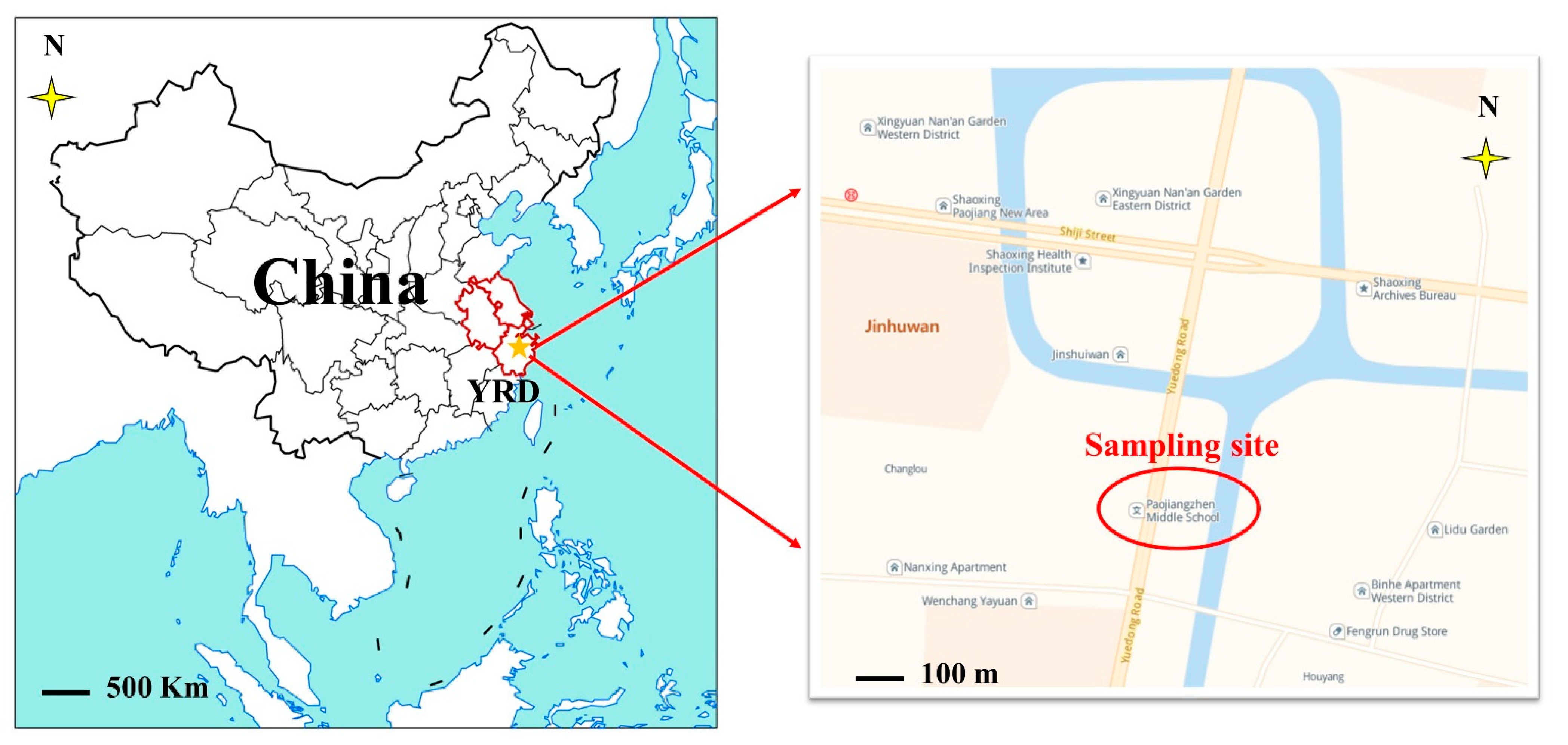
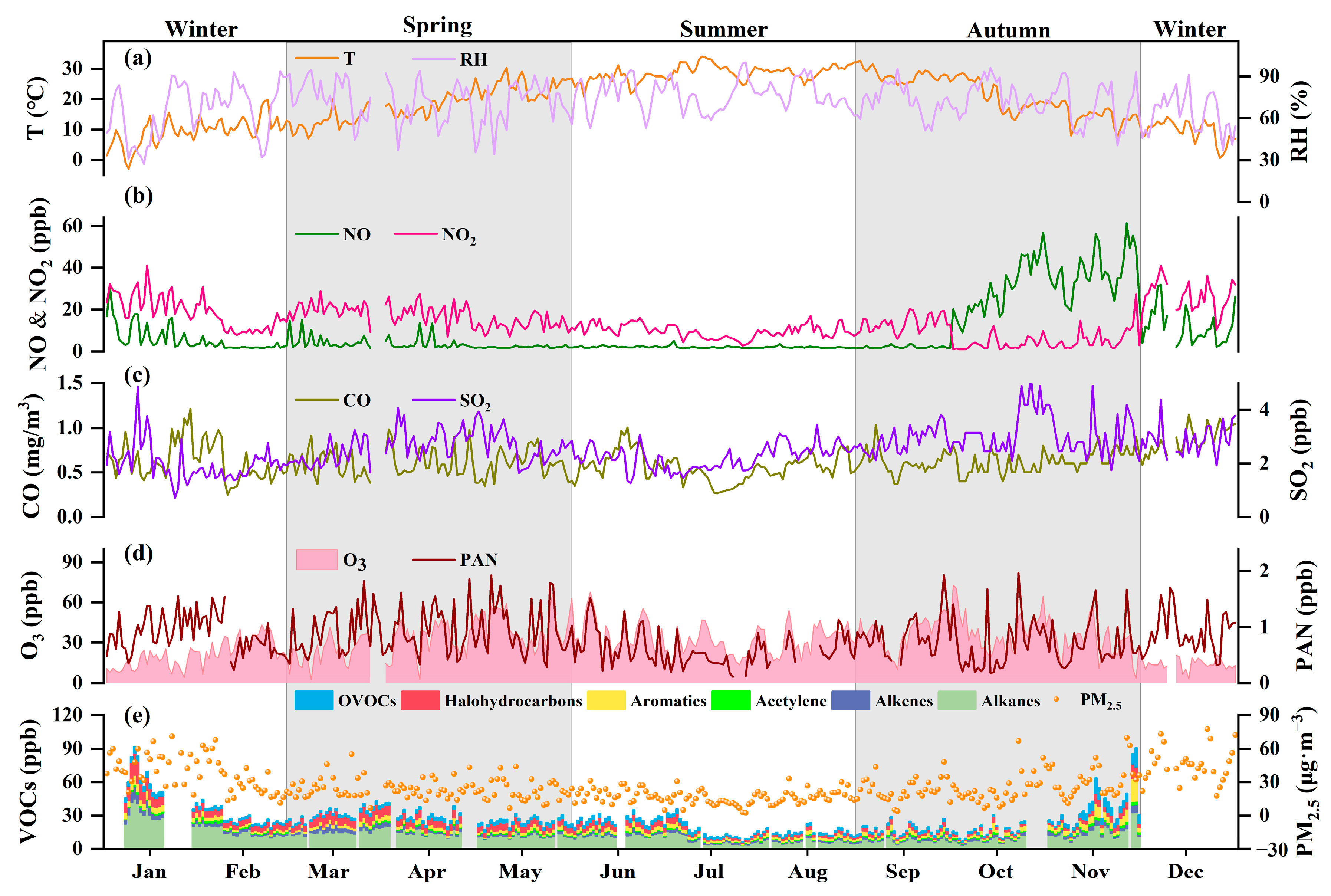

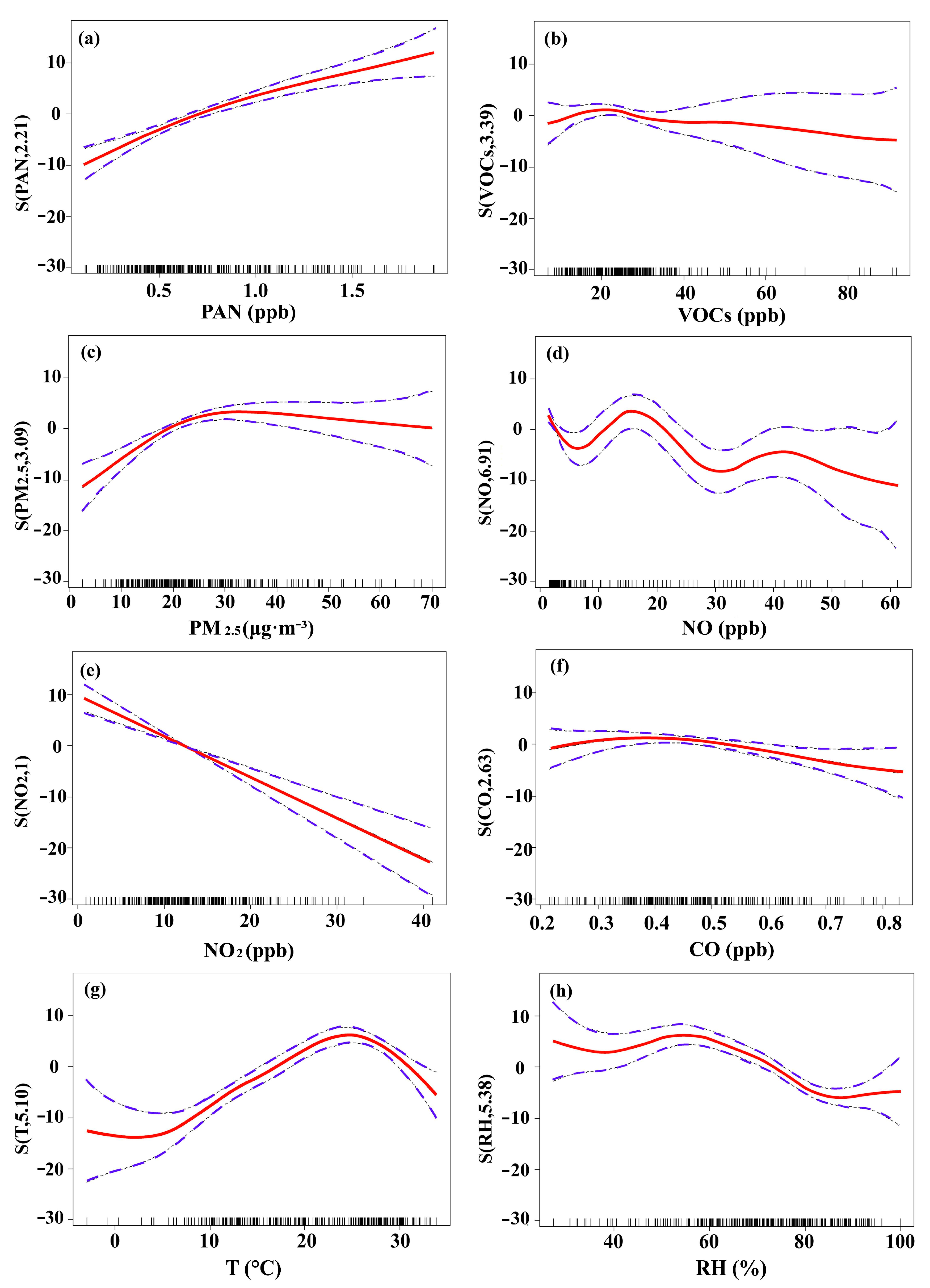
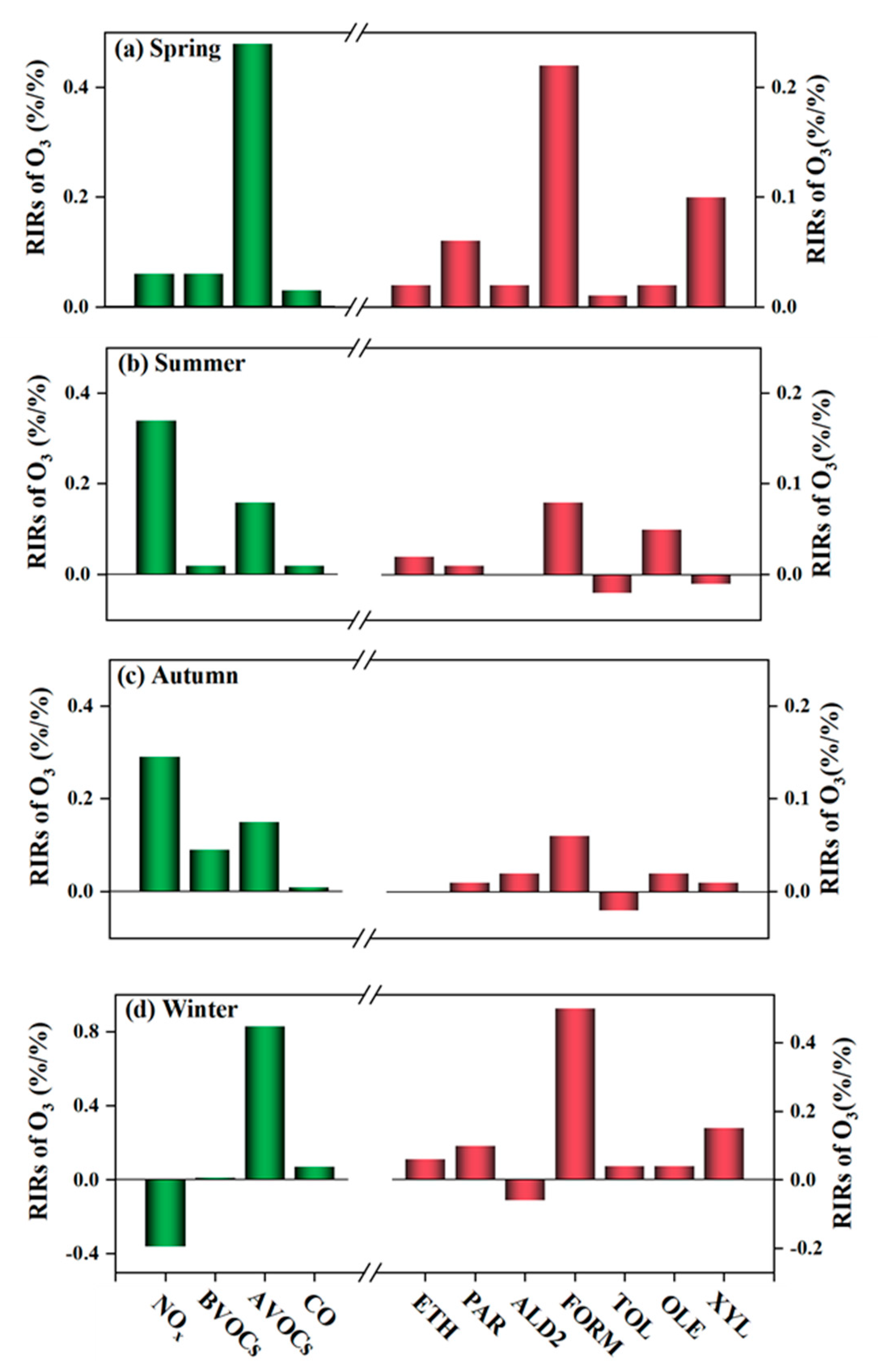
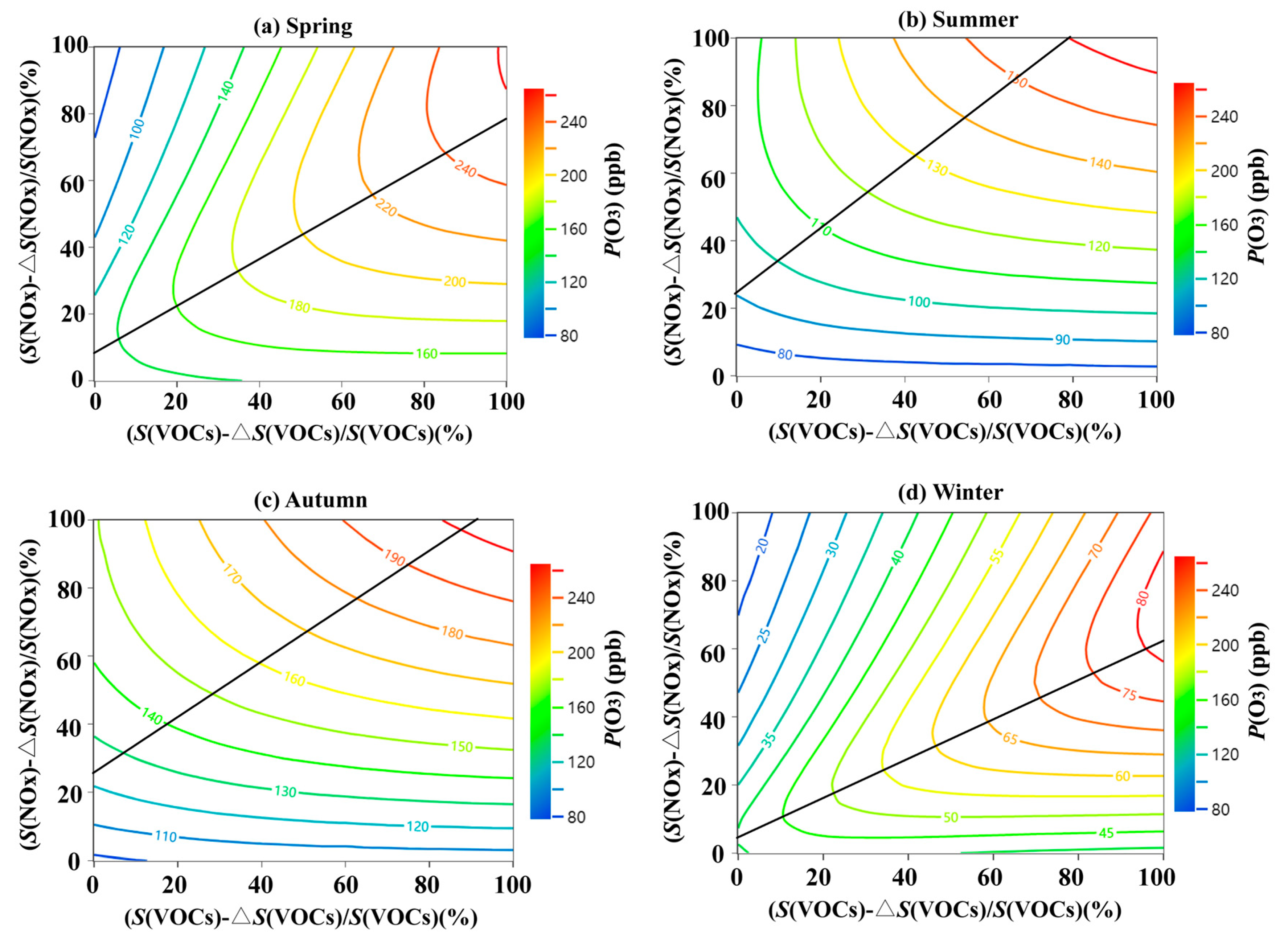
| Mean | |||||
|---|---|---|---|---|---|
| Spring | Summer | Autumn | Winter | Year | |
| O3 (ppb) | 32.89 ± 14.00 | 32.70 ± 11.41 | 36.16 ± 13.28 | 19.03 ± 9.21 | 30.27 ± 13.78 |
| PAN (ppb) | 0.94 ± 0.42 | 0.59 ± 0.30 | 0.75 ± 0.40 | 0.88 ± 0.35 | 0.81 ± 0.42 |
| VOCs (ppb) | 28.74 ± 5.78 | 19.14 ± 7.34 | 24.04 ± 14.80 | 39.03 ± 18.08 | 26.18 ± 13.33 |
| PM2.5 (μg·m−3) | 23.86 ± 8.83 | 16.74 ± 6.39 | 25.78 ± 12.18 | 40.87 ± 15.94 | 26.66 ± 14.36 |
| NO (ppb) | 3.47 ± 2.79 | 2.12 ± 0.49 | 23.27 ± 17.85 | 7.71 ± 7.29 | 9.18 ± 12.94 |
| NO2 (ppb) | 16.95 ± 5.06 | 9.64 ± 3.21 | 7.62 ± 5.88 | 21.46 ± 8.52 | 13.82 ± 8.15 |
| SO2 (ppb) | 2.64 ± 0.58 | 2.23 ± 0.44 | 3.03 ± 0.71 | 2.29 ± 0.77 | 2.55 ± 0.71 |
| CO (mg·m−3) | 0.61 ± 0.15 | 0.56 ± 0.15 | 0.62 ± 0.12 | 0.71 ± 0.22 | 0.62 ± 0.18 |
| T (°C) | 18.50 ± 5.57 | 28.58 ± 2.57 | 21.14 ± 6.36 | 9.45 ± 4.12 | 19.48 ± 8.41 |
| RH (%) | 71.68 ± 14.45 | 76.81 ± 10.86 | 72.32 ± 12.65 | 64.39 ± 17.19 | 71.33 ± 14.66 |
| Smoothed Variables | Smooth Terms | |||
|---|---|---|---|---|
| Edf | Ref.df | F Value | p Value | |
| PAN (ppb) | 2.16 | 2.75 | 24.22 | 0.00 |
| VOCs (ppb) | 3.99 | 4.94 | 1.05 | 0.03 |
| PM2.5 (μg·m−3) | 3.09 | 3.87 | 9.12 | 0.00 |
| NO (ppb) | 6.91 | 7.97 | 4.85 | 0.00 |
| NO2 (ppb) | 1.00 | 1.00 | 47.88 | 0.00 |
| CO (mg·m−3) | 2.63 | 3.30 | 3.25 | 0.01 |
| T (°C) | 5.10 | 6.20 | 22.34 | 0.00 |
| RH (%) | 5.38 | 6.51 | 13.22 | 0.00 |
| Deviance explained (%) = 83 %, Adjust R2 = 0.80 | ||||
Disclaimer/Publisher’s Note: The statements, opinions and data contained in all publications are solely those of the individual author(s) and contributor(s) and not of MDPI and/or the editor(s). MDPI and/or the editor(s) disclaim responsibility for any injury to people or property resulting from any ideas, methods, instructions or products referred to in the content. |
© 2022 by the authors. Licensee MDPI, Basel, Switzerland. This article is an open access article distributed under the terms and conditions of the Creative Commons Attribution (CC BY) license (https://creativecommons.org/licenses/by/4.0/).
Share and Cite
Lu, Y.; Wu, Z.; Pang, X.; Wu, H.; Xing, B.; Li, J.; Xiang, Q.; Chen, J.; Shi, D. Temporal Characteristics of Ozone (O3) in the Representative City of the Yangtze River Delta: Explanatory Factors and Sensitivity Analysis. Int. J. Environ. Res. Public Health 2023, 20, 168. https://doi.org/10.3390/ijerph20010168
Lu Y, Wu Z, Pang X, Wu H, Xing B, Li J, Xiang Q, Chen J, Shi D. Temporal Characteristics of Ozone (O3) in the Representative City of the Yangtze River Delta: Explanatory Factors and Sensitivity Analysis. International Journal of Environmental Research and Public Health. 2023; 20(1):168. https://doi.org/10.3390/ijerph20010168
Chicago/Turabian StyleLu, Yu, Zhentao Wu, Xiaobing Pang, Hai Wu, Bo Xing, Jingjing Li, Qiaoming Xiang, Jianmeng Chen, and Dongfeng Shi. 2023. "Temporal Characteristics of Ozone (O3) in the Representative City of the Yangtze River Delta: Explanatory Factors and Sensitivity Analysis" International Journal of Environmental Research and Public Health 20, no. 1: 168. https://doi.org/10.3390/ijerph20010168
APA StyleLu, Y., Wu, Z., Pang, X., Wu, H., Xing, B., Li, J., Xiang, Q., Chen, J., & Shi, D. (2023). Temporal Characteristics of Ozone (O3) in the Representative City of the Yangtze River Delta: Explanatory Factors and Sensitivity Analysis. International Journal of Environmental Research and Public Health, 20(1), 168. https://doi.org/10.3390/ijerph20010168









